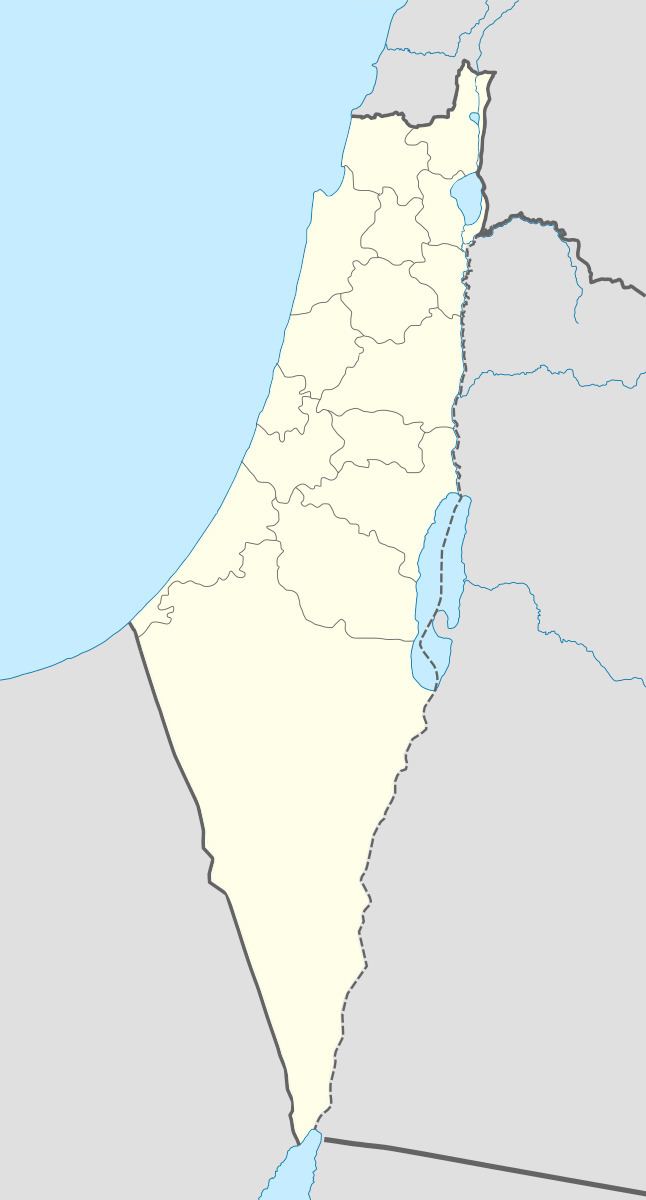Arabic ابو شوشة Palestine grid 142/140 Local time Tuesday 10:39 PM Date of depopulation 14 May 1948 | Subdistrict Ramle Area 9,425 dunams9.4 km² | |
 | ||
Name meaning Father of the top-knots Weather 19°C, Wind N at 16 km/h, 36% Humidity | ||
Abu Shusha (Arabic: ابو شوشة) was a Palestinian Arab village in the Ramle Subdistrict of Mandatory Palestine, located 8 km southeast of Ramle. It was depopulated in May 1948.
Contents
Abu Shusha was located on the slope of Tel Jazar, which is commonly identified with the ancient city of Gezer. In April–May 1948, during the 1948 Arab–Israeli War, Abu Shusha was attacked several times. The final assault began on May 13, one day prior to Israel's declaration of independence. Abu Shusha residents attempted to defend the village, but the village was occupied on May 14. Those residents who had not already died or fled were expelled by May 21. With their descendants, they numbered about 6,198 in 1998.
Name
Abu Shusheh is said to derive its name from a derwish who prayed for rain in a time of drought, and was told by a sand-diviner that he would perish if it came. The water came out of the earth (probably at Et Tannur) and formed a pool, into which he stepped and was drowned. The people, seeing only his topknot left, cried Ya Abu Shusheh (“Oh Father of the Topknot”)
History
The Crusaders called the place Mont Gisart. In 1177 the Crusaders won a battle against Saladin there. Ceramics and coins from the 13th century have been found.
Ottoman era
A maqam (shrine) was built there in the 16th century. Edward Robinson noted the village on his travels in the region in 1852.
In 1882, the Palestine Exploration Fund's Survey of Western Palestine (SWP) described Abu Shusha as a small village built of stone and adobe and surrounded by cactus hedges, populated by about 100 families.
In 1869 or 1872, the village lands were purchased by Melville Peter Bergheim of Jerusalem, a Protestant of German origin. Bergheim established a modern agricultural farm, using European methods and equipment. Bergheim's ownership of the land was hotly contested by the villagers, by legal and illegal means. After the Bergheim company went bankrupt in 1892, Abu Shusa's lands were managed by a government receiver. In 1882, the Palestine Exploration Fund's Survey of Western Palestine noted that the extent of land farmed by Mr. Bergheim at Abu Shusheh was 5,000 acres. The boundaries was shown on the Survey's map as a dotted line: ____ . . . . _____ . . . .
Elihu Grant, who visited the village, described it as "tiny" in 1907. In 1910s, part of the land was sold by the government receiver to the villagers and the rest to the Jewish Colonization Association, which gave the villagers one third of their purchase in order to settle the dispute. After World War I, the land in Jewish hands was sold to the Maccabean Land Company, and later transferred to the Jewish National Fund.
In November, 1917, the British 6th Mounted Brigade charged a Turkish detachment defending the heights above Abu Shusheh. The Turks suffered 'heavy casualties'.
British Mandate era
In a census conducted in 1922 by the British Mandate authorities, Abu Shusheh had a population of 603 residents; all Muslims, increasing in the 1931 census to 627, still all Muslims, in a total of 145 houses.
The village had a mosque and a number of shops. A village school was founded in 1947, with an initial enrollment of 33 students.
In 1945, the population of Abu Shusha was 870, all Muslims, with a total land area of 9,425 dunams. 2,475 dunums of village land were allotted to cereals, 54 dunums were irrigated or used for orchards, while 24 dunams were built-up (urban) areas.
1948 massacre and aftermath
The village was attacked by the Givati Brigade on May 13–14, 1948 during Operation Barak. A few inhabitants fled but most remained. The Givati troops were immediately replaced by militia men from kibbutz Gezer, who were later replaced by troops from Kiryati Brigade. On May 19, Arab Legion sources claimed that villagers were being killed. On May 21, Arab authorities appealed to the Red Cross to stop "barbaric acts" they said were being committed in Abu Shusha. A Haganah soldier was reported to have twice attempted to rape a 20-year-old woman prisoner. The residents that had remained in the village were expelled, apparently on 21 May.
More recently, research conducted by Birzeit University, mostly on the basis of interviews with former residents, suggests that between 60-70 residents were killed or massacred during the attack. In 1995 a mass grave with 52 skeletons was discovered, but their cause of death is undetermined.
Israeli historian, Aryeh Yitzhaki, explains the events of Abu Shusha as a massacre citing a testimony from the Kheil Mishmar (Guard Units):
"A soldier of Kiryati Brigade captured 10 men and 2 women. All were killed except a young woman who was raped and disposed of. At the dawn of 14 May, units of Giv'ati brigade assaulted Abu Shusha village. Fleeing villagers were shot on sight. Others were killed in the streets or axed to death. Some were lined up against a wall and executed. No men were left; women had to bury the dead."
The Israeli settlement of Ameilim was founded nearby later in 1948, while Pedaya was established in 1951; both on village land. The remains of the village were destroyed in 1965 as part of a government operation to clear the country of abandoned villages, which were regarded by the Israel Land Administration as "a blot on the landscape".
